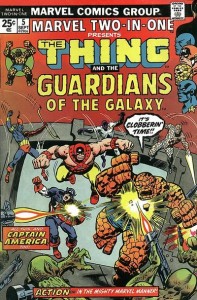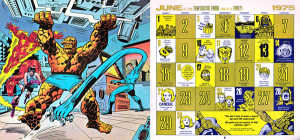 Marvel Two-In-One. The title kinda says it all, doesn’t it? You buy this book, you’re getting two for the price of one. In this case, two super-heroes. On a smaller scale, it’s the logic that, in the 1940s, led National Comics and All-American Comics to create the Justice Society, or, later, DC Comics to create the Justice League. It’s like this: Some kid has only one dime, and doesn’t know if he wants to read The Flash or Green Lantern. Hey, kid, suppose you could get both for one thin dime? And a bunch of other characters besides? Wow! It’s like getting free super-heroes!
Marvel Two-In-One. The title kinda says it all, doesn’t it? You buy this book, you’re getting two for the price of one. In this case, two super-heroes. On a smaller scale, it’s the logic that, in the 1940s, led National Comics and All-American Comics to create the Justice Society, or, later, DC Comics to create the Justice League. It’s like this: Some kid has only one dime, and doesn’t know if he wants to read The Flash or Green Lantern. Hey, kid, suppose you could get both for one thin dime? And a bunch of other characters besides? Wow! It’s like getting free super-heroes!
And of course, what you don’t say to the kid is that you hope he’ll get hooked on the “free” super-heroes, and, instead of one thin dime a week, start spending five or six dimes a week, so he can keep up with all those new characters he’s been introduced to. It’s the same principle by which drug dealers give away free crack. (I infer. Do drug-dealers give away free crack? I’ve never met a drug dealer. That I know of.)
You get the idea. It’s all about sales. In this case, The Thing was the breakout character from the Fantastic Four, so let’s give him his own title. But wait, maybe he can’t carry his own title… After all, he’s called The Thing. It’s not “Batman,” now it it? But suppose we team him with another character? A different character every month?
Yeah!
Again, team-ups were not new. Besides the Justice League and Justice Society, there were the All-Winners, the Seven Soldiers of Victory, the Avengers, the Defenders… Superman and Batman had for years teamed up in the pages of World’s Finest Comics. Even the idea of one popular character teaming with lesser-knowns was not new in 1974. Batman had been teaming with every character in the DC stable in The Brave and the Bold since the late 1960s. Spider-Man had headline Marvel Team-Up since 1972. Superman came late to the party. DC Comics Presents didn’t premiere until 1978.
You’d expect a collection of two-hero team-ups to be the most blatant kind of non-continuity crap, unrelated to anything that might be happening in the title in which either of the co-stars regularly appeared, if they were lucky enough to have a regular title. Such a book, especially in the 1970s when the word “continuity” had yet to even be applied to comics, would be created just so that two popular characters could be on the cover, right?
That’s pretty much exactly what The Brave and the Bold was. I just finished reading a dozen and a half issues of that title, too. Fun as those stories were, under the direction of Bob Haney, even Batman, the nominal “star” of the series, was not the same character issue to issue. He changed to fit the needs of the story. The Batman appearing in B & B certainly had nothing to do with the Batman appearing monthly in Detective Comics or in his own eponymous title. That was the way Bob Haney wrote. His stories were heavy on character, but light on characterization. The heroes acted emotionally only because the story called for them to, not because the integrity of their characters demanded that they should. Wonder Woman could fall head over heels in love with Batman, not because she was being manipulated by villains, but because the plot called for a woman to get emotional over a man. That the woman was an Amazon and the man a career loner didn’t enter into it.
But Marvel Two-in-One broke that mold. The first twelve issues (two appeared in the last issues of a “tryout” book called Marvel Feature), largely under the guidance of storyteller Steve Gerber, creator of Howard the Duck, had an overall story thread. Although Ben Grimm, The Thing, was also appearing regularly in The Fantastic Four, this title made readers feel that they were following Ben’s life pretty closely even if they weren’t reading both books, even as it meshed well with events over in FF.
So Reed, Johnny and Medusa make frequent appearances, even though this is Ben’s “solo” book. Medusa? Yes, Medusa. For the unenlightened, the membership of the Fantastic Four has not been stable, even from the beginning. The first really long stretch in which a found member of the team was replaced by someone else came in the 1970s, when The Invisible Girl dropped out to be replaced by Medusa of the Inhumans.
I never understood the motivation for this change. The Invisible Girl is more powerful than Medusa, if perhaps a bit less visually exciting, since, when she uses her power, you can’t see her. Whereas Medusa has wacky, prehensile red hair. I think perhaps the thinking was that Medusa is regal and arrogant, whereas Sue Storm Richards is one of the nicest women in comicdom. This may have been the first wave of an attitude (sadly firmly entrenched in comics and adventure stories in general now) which says that nice women are boring and unbelievable. Certainly the producers of the last two Fantastic Four films thought so. Jessica Alba’s Sue was a downright shallow bitch at times.
Other changes came later, when the She-Hulk replaced Ben, or Ms. Marvel (who became She-Thing) and Medusa’s sister Crystal replaced Reed and Sue, or The Black Panther and Storm replaced Reed and Sue, or Johnny died and was replaced by… I dunno… I didn’t read that arc. Eventually, though, all these changes are always undone because, well, the merchandising for the book always shows the original four: Reed, Sue, Ben and Johnny, or Mr. Fantastic, The Invisible Girl (Woman), The Human Torch and The Thing. If the team has a different lineup for too long, new and casual readers get confused. I know I did. When I first discovered the FF, it was via their origin story, recapped in Dynamite Magazine’s “Super-Heroes Confidential” feature, and via their page on my 1975 Marvel Calendar. (I’ve mentioned this calendar before, and here’s a wonderful blog that features the images. And I–holy crap!–that calendar is good this year! And the FF is this month’s picture!) The origin showed Sue and never mentioned Medusa, but Sue was absent from the calendar. It boggled my eight-year-old mind.
 Gerber managed to make this book an actual title, with running subplots and a supporting cast of its own, and a running story thread. Gerber was good at this, and he had the advantage of being the writer of several other books at the same time. He was writing Daredevil and the Defenders at the time, as well as Man-Thing and the Sub-Mariner. It’s not suprise, therefore, that, in addition to Alicia Masters, Ben’s long-suffering girlfriend, daughter of his arch-foe The Puppet Master, Gerber lined up supporting characters from his other books.
Gerber managed to make this book an actual title, with running subplots and a supporting cast of its own, and a running story thread. Gerber was good at this, and he had the advantage of being the writer of several other books at the same time. He was writing Daredevil and the Defenders at the time, as well as Man-Thing and the Sub-Mariner. It’s not suprise, therefore, that, in addition to Alicia Masters, Ben’s long-suffering girlfriend, daughter of his arch-foe The Puppet Master, Gerber lined up supporting characters from his other books.
Wundarr was a Superman parody first introduced in the pages of Man-Thing’s series in Fear…
Wait, Man-Thing? Yeah… there was a character called “Man-Thing.” More embarrassing, he had a title called Giant-Size Man Thing, and it had more than one issue. I guess minds weren’t as dirty in the 1970s, or at least we weren’t willing to admit that they were.
So, yeah, Wundarr. Super-strong kid from another planet, rocketed to Earth by his scientist father, who was the only one of his race that knew their planet was dying. Sound familiar? No? Oh, that’s right, Superman’s dead and the Man of Steel has replaced him. My bad. Y’all probably don’t remember Superman. But the MoS also had a scientist father who… wait… was he a scientist? I think maybe he was a bookie…
But Wundarr’s dad was a scientist, and Wundarr grew up in an isolation tank, never forming an adult personality. When he was accidentally released by the swamp monster Man-Thing — <giggle> <stop that!> — he thought the gelatinous mass of green goo was his mommy, and was sad to be re-buffed by it. But then he was found by the Sub-Mariner’s cousin, Namorita, and adopted her as his big sister. Her regal cousin, Prince Namor, had better things to do, however, than have a super-powered infant running around the hallowed halls of Atlantis, so he summarily dumped this unlikely charge on The Thing, or “Unca Ben” as he became for the next many issues.
Ben did all the uncle-nephew things with Wundarr, taking him to the zoo, buying him balloons and cotton candy, fighting invading aliens… And, along the way, he acquired a second supporting character in Namorita, who moved to New York with her best friend Annie, and stayed close to the super-powered alien she’d found on the beach.
This collection includes some big Marvel stars — The Hulk, Iron Man, Captain America, Agent 13, Ghost Rider, Thor and the Black Widow — as well as pretty much every character Gerber was writing in other series — Man-Thing, Sub-Mariner, Daredevil, Shanna the She-Devil, Guardians of the Galaxy, Dr. Strange, and the Valkyrie.
And, honestly, Strange, Daredevil and Subby are all legit big names too. The Guardians soon will be, although it’s a different team of Guardians in the upcoming film, and the Black Widow counts as a Gerber character, too, since she was also a co-star in Daredevil at the time.
The neat thing about all these guest stars is that, even with the ones that weren’t his “property,” Gerber was well-versed in what drove them. In particular his Ghost Rider story ties into events in the character’s own title, and really gets into the head of the hell-driven cyclist. That may be the benefit of having a small, focused “bullpen.” On the other hand, these were the days when writers were allowed, far more often, to do what they wanted. I still feel the Marvel stories of the 1970s have never been equaled, so I think that looser control worked better. I choose to believe that the late, great Mr. Gerber just cared enough to research the characters he was writing.
Well worth the read for a taste of all that was Marvel in the 1970s, without the overhead of reading long-running arcs of stories.
